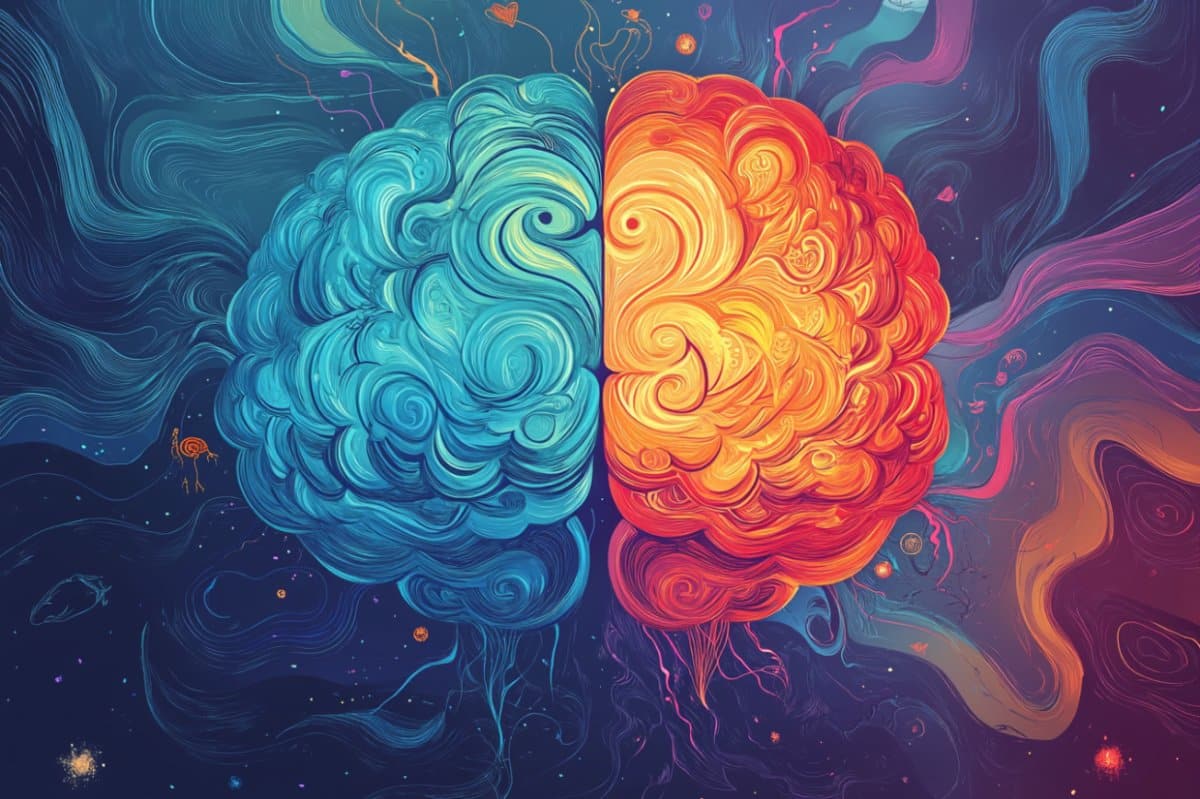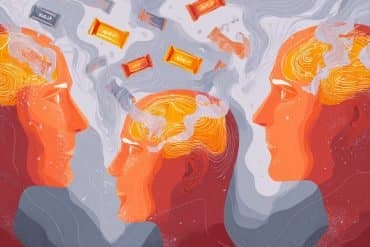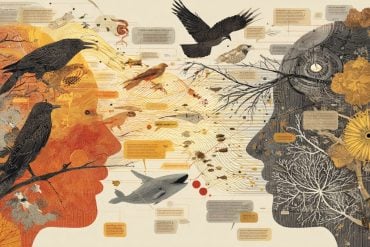Summary: A new theory suggests that psychedelics promote empathy, insight, and psychological flexibility by making the brain’s right hemisphere temporarily dominant over the left. Known as HEALS—Hemispheric Annealing and Lateralization Under Psychedelics—this model proposes that psychedelics disrupt the typical hierarchy between hemispheres, releasing the more holistic, emotionally intelligent right side from left-brain control.
Neuroimaging shows a rightward shift in brain activity under psychedelics, aligning with traits often enhanced during these experiences, like mindfulness, empathy, and clarity. Research also finds parallels between the effects of psychedelics and practices like meditation, which also strengthen right-hemisphere networks.
Key Facts:
- HEALS Model: Proposes that psychedelics shift dominance from the left to the right hemisphere.
- Emotional Benefits: Right-brain dominance may enhance empathy, creativity, and insight.
- Neural Evidence: Neuroimaging shows increased right-hemisphere activity under psychedelics.
Source: Ohio State University
The secret to psychedelic drugs’ links to greater empathy and insight may lie in their ability to coax the right hemisphere of the brain into a position of dominance over the left, according to a proposed new theory.
Researcher Adam Levin combined his experience in therapeutic psychedelics research and psychiatric training with a review of imaging, numerous studies and previous models to support his proposal, published in the Journal of Psychopharmacology.
In this context, Levin emphasizes not what the two brain hemispheres do, but how they approach a topic or task – working in parallel, with left-brain dominance, during typical modes of consciousness.
When we’re solving a problem, or, evolutionarily speaking, hunting for food, for example, the scope of attention differs: The left hemisphere focuses on manipulation of individual parts while the right hemisphere maintains a big-picture frame of reference.
“In the psychedelic state, there’s a unique combination of the hemispheres coming together in a way that doesn’t usually happen in normal states of consciousness,” said Levin, a postdoctoral scholar and psychiatrist in the Center for Psychedelic Drug Research and Education in The Ohio State University College of Social Work.
“It’s almost a new encounter between the left and the right hemispheres’ way of thinking and perceiving the world.”
He calls this model of psychedelic action HEALS: Hemispheric Annealing and Lateralization Under Psychedelics.
In effect, he suggests, psychedelics reverse the hierarchical relationship between the two hemispheres of the brain, releasing the right hemisphere from inhibition by the left.
Levin was initially inspired in part by the writings of Iain McGilchrist, author of “The Master and His Emissary: The Divided Brain and the Making of the Western World.”
But his own clinical experience as a medical student and psychiatry resident gave Levin an up-close look at how disorders affecting one side of the brain or the other affected patients’ world view.
“In people who lose the right hemisphere to stroke, the attentional window gets so narrow and they don’t even recognize a whole half of the world. Whereas people with an intact right hemisphere, who lose their left hemisphere, still have a broader general picture of things,” he said.
“A lot of these people’s experiences seem, to me, to be similar to what I’m seeing in my psychedelic research.”
Previous hypotheses about psychedelics’ effects on the brain have suggested “unrestrained cognition” occurs through the weakening of control exerted by frontal lobes and the top of the brain.
While that is likely true, Levin said, patterns observed in people’s reports of their psychedelic experiences suggest there’s more going on: There are increases in psychological flexibility, creativity, and social and emotional intelligence; greater empathy, harmony and connection; a broader attentional window toward novelty and “aliveness”; and clarity and insight about one’s basic existence and, in some cases, need for healing.
“Those general patterns are awfully similar to the pattern of the right hemisphere,” he said.
“And I think psychedelics provide access to this whole picture, this whole view, that could have been operating in the background – and that’s this right hemisphere view. Restoration of this natural balance is an interesting way of explaining some of what’s happening.”
Neuroimaging studies of lateral changes to brain blood flow and metabolism – brain regions’ use of glucose – that Levin analyzed showed signs of heavy activity in the frontal lobes in the right hemisphere as well as an overall rightward shift in metabolic activity under psychedelics, he said.
The growing evidence that mindfulness meditation practice is linked to building new networks in the brain and increasing brain thickness in the right hemisphere is relevant to the HEALS theory, as well.
“Psychedelics have been linked to improvements in mindfulness with just one or two uses. And sometimes these capacities are almost at levels consistent with practiced meditators,” Levin said.
“That makes it likely, to me, that many core right-sided networks that are enhanced with practicing meditation might be enhanced briefly, or maybe longer, through psychedelics.
“I think there’s an opportunity after the use of psychedelics to increase and sustain mindfulness capacities in these areas of the right hemisphere.”
The field of psychedelic research is focused on therapeutic applications at Ohio State and elsewhere, but Levin expects that expansion of the field will stimulate pursuit of other research questions – including testing theories about how these substances act on the brain.
He considers HEALS a complement to earlier theories about psychedelic action, and expects the growth in research to produce more hypotheses.
“I think to explain something as complex as the brain, especially in the human being, you need a variety of theories to more closely approximate what’s actually happening,” he said.
“If we get too fixated on one explanation or the other, we’re going to lose track of reality.”
About this psychopharmacology and neuroscience research news
Author: Emily Caldwell
Source: Ohio State University
Contact: Emily Caldwell – Ohio State University
Image: The image is credited to Neuroscience News
Original Research: Open access.
“Hemispheric annealing and lateralization under psychedelics (HEALS): A novel hypothesis of psychedelic action in the brain” by Adam Levin et al. Journal of Psychopharmacology
Abstract
Hemispheric annealing and lateralization under psychedelics (HEALS): A novel hypothesis of psychedelic action in the brain
Current models of psychedelic action in the brain propose changes along the dorsal–ventral and anterior–posterior axes but neglect to address the lateral axis.
This article proposes a novel model of psychedelic action called HEALS (Hemispheric Annealing and Lateralization Under Psychedelics) which involves the reversal of the typical hierarchical relationship between the two hemispheres of the brain.
In typical modes of consciousness, the hemispheres act in parallel process with the left predominating.
Under psychedelics, as well as in other altered states of consciousness (ASCs), this hierarchy is reversed, with the right hemisphere released from inhibition by the left.
In support of this model, the available neuroimaging evidence for lateralization under psychedelics is reviewed.
Then, various cognitive and emotional changes observed under psychedelics are contrasted with those same functions in each hemisphere.
These include attention; social and emotional intelligence; creativity and insight; and language.
The article concludes with a review of laterality in other ASCs, such as meditative and trance states, and suggests that many phenomena associated with psychedelics, and other ASCs, might be explained by an atypical annealing between the hemispheres toward right hemisphere predominance.







